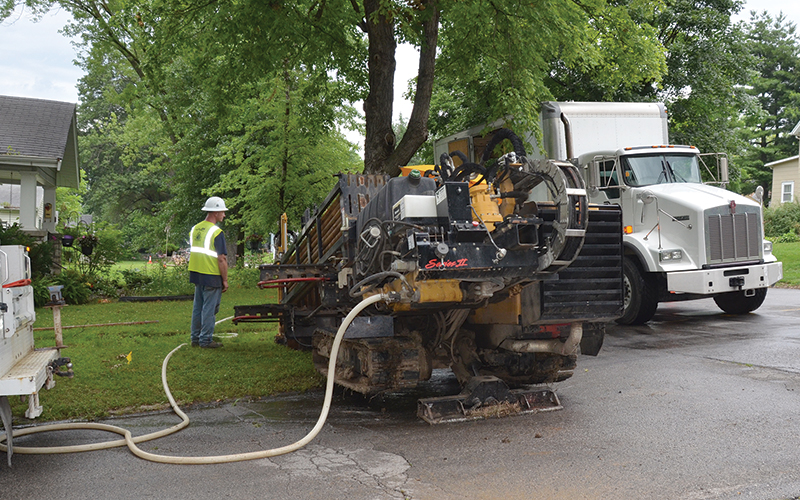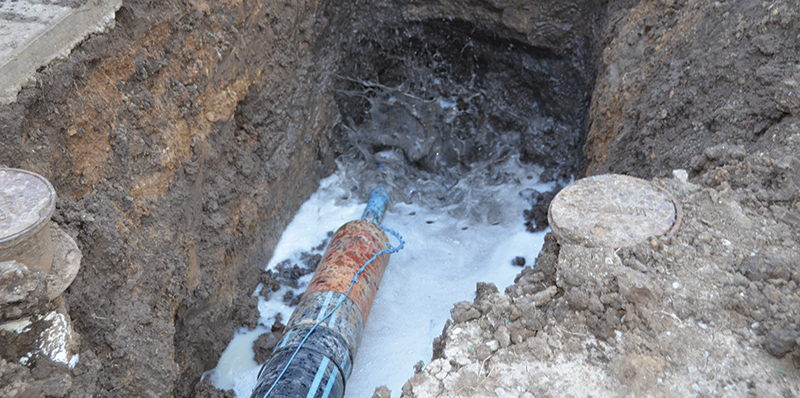October 2015 Vol. 70 No. 10
Features
Polyethylene Pipe Installation Revitalizes 1800s Neighborhood

Leavenworth, founded in 1854, is the oldest city in Kansas. Workers have actually unearther some wooden pipelines, but many are cast iron that have long-served their time for the city’s 36,000 residents. Today, those pipes are often corroded to the point of leaking and even bursting.
About a decade ago, Leavenworth Waterworks began supplementing with a new pipe material to update their water infrastructure with high density polyethylene pipe (HDPE. This material was selected because of its long-term benefits and its performance to date. Today, approximately 6 percent of Leavenworth’s water pipelines are HDPE with ductile (48 percent) and cast iron (33 percent) still representing the majority of older pipelines. That leaves plenty of room for the HDPE market to grow.
HDPE pipe doesn’t corrode and when fused together properly, proponents claim there is zero leakage. Metal pipes have an allowable leakage which increases the amount of water cities have to treat for drinking water with those costs passed on to the customer.
An HDPE pipe installation is also less disruptive because often fused pipe can be pulled underground with horizontal directional drilling. They don’t have to dig long open trenches or tear up streets and there is less disruption to yards and driveways.
Leavenworth Waterworks recently awarded NPL Construction two contracts totaling $1.2 million for 2.25 miles of waterline replacements. NPL is involved in many facets of the project having expertise in pipe fusion, boring, pre-fabrication of mechanical-joint adapters and utility location.
The first project was for new installation along Columbia Avenue. This is an older section of town with a strong sense of historical pride and character. Many homes on the mature tree-lined street were built in the 1800s and are marked by plaques noting the circa year they were built.
Replacing old, small pipe
The existing cast iron pipe serving this neighborhood is 65 to 70-years old and is only two-inches in diameter which causes water pressure issues for some residents. It is being replaced with eight-inch DIPS DR11 DriscoPlex HDPE pipe supplied by Industrial Sales. They opted for much larger pipe for added fire protection in the neighborhood.
HDPE pipe is joined together by heat or butt fusion. With this process, the pipe ends are melted by applying heat then joined together at specific temperatures and pressures. The result is a seamless joint that creates one continual stretch of pipe strong enough to be pulled underground for an entire residential block, which in this case ranged anywhere from 500 to 670 feet.
“It works really well,” said Kayla Manning, engineer for Leavenworth Waterworks. “This is an older neighborhood with mature trees – it’s a better way to go and we can leave the streets open. There’s minimal cutting of the street.”
McElroy Manufacturing Inc., Tulsa, OK, is one of the best-known companies in pipe fusion, having designed a full line of rugged equipment for a wide range of pipe sizes.
At this jobsite, a McElroy track-mounted machine was used. The TracStar 618 was purchased from Industrial Sales who also provided on-site technical support. The TracStar lines are self-propelled so operators can maneuver the machine down the street, on sidewalks or on more rugged right-of-ways to each fusion location. The units are also self-contained which eliminates the need to have a generator on site.
The four-jaw unit comes with hydraulic clamping and a rotating facer, which makes a fresh and even cut on the pipe ends so that it can be fused properly. A heater plate is then placed between the pipe ends which are pushed against the heater at the correct pressure which results in the fusion.
A McElroy PolyPorter – part dolly, part pipe stand –was used to help load pipe into the machine and support fused lengths of pipe as they extended from the fusion machine.
NPL operators fused several 40-foot pipe sticks and staged the fused lengths along a side street while the bore was being made. A drill operator was situated on a street corner and bored to the next street corner, passing beneath front yards, driveways and cross streets. The streets were left open to traffic.
Low impacts
“The advantage to this is we don’t disturb people’s yards,” said NPL Project Manager Johnny Bauer.
Once the bore was complete, the fusion operators and the drilling operator prepared to pull the pipe an entire block. Because HDPE is flexible, the fusion crew was able to use a roller cradle to curl the pipe around a corner, make the final fusions and position it to be pulled in one direction.
It sounds like a daunting task but the Vermeer D24x40 drilling rig had ample power to handle the job. At the end of the drill head are jets that shoot 20 gallons of water a minute to plow through earth and tree roots. Several relief holes are dug to relieve the water pressure so it doesn’t erupt through the ground. Workers use track hoes to haul off the mud that oozes through the holes.
NPL locates all utilities ahead of time to prevent damaging sewer lines during the bore and the pull.
Manning said that environmental regulations are emerging that require permitting any time more than a half-acre of land is disturbed. This makes boring a great option since very little land in comparison to open-cut methods has to be disturbed.
To expedite the process, NPL fabricated mechanical joint adapters ahead of time to connect to ductile iron tees and valves at every new fire hydrant. The MJ adapters are used to transition successfully from metal to HDPE.
NPL, headquartered in Phoenix, is one of the largest gas distribution contractors in the U.S. and is moving steadily into the municipal water industry. It has one of the top private fleets in the nation and is one of the largest owners of McElroy equipment.
NPL’s pipe fusion crew in Leavenworth is certified to operate with two gas companies. Leavenworth Waterworks accepts their qualifications through the gas companies – which require much more stringent checks and balances than the water industry.
The project started June 1 and was completed in September 2015.
FOR MORE INFORMATION:
NPL, (623) 582-1235, www.gonpl.com
McElroy Manufacturing, (918) 836-8611, www.mcelroy.com
Vermeer Corp., (888) 837-6337, www.vermeer.com
Industrial Sales, (913) 829-3500, www.industrialsales.us






Comments